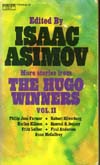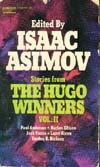Stories from the Hugo Winners, Vol. II
The Hugo Award is to science fiction what the Oscar is to the film industry. Every year the coveted award is presented at the World Science Fiction Convention to the author of the best novelette or short story in the realm of science fiction.
Here are six of these award-winning stories for the years 1963 to 1967, each with an introduction by Isaac Asimov. All of the stories are unusual and contain that special something that marked them as prize-winners. Among them are Poul Anderson’s “No Truce with Kings,” Jack Vance’s “The Dragon Masters,” and Larry Niven’s “Neutron Star.”
THE HUGO WINNERS provides a lavish treat of the very best writing chosen by the most prominent people in the field—truly superior science fiction.
More Stories from the Hugo Winners, Vol. II
The Hugo Award is to science fiction what the Oscar is to the film industry. Every year the coveted award is presented at the World Science Fiction Convention to the author of the best novelette or short story in the realm of science fiction.
Here are eight of these award-winning stories for the years 1968 to 1970, each with an introduction by Isaac Asimov. All of the stories are unusual and contain that special something that marked them as prize-winners. Among them are Anne McCaffrey’s “Weyr Search,” Fritz Leiber’s “Gonna Roll the Bones,” and Harlan Ellison’s “I Have No Mouth and I Must Scream.”
THE HUGO WINNERS provides a lavish treat of the very best writing chosen by the most prominent people in the field—truly superior science fiction.
This is an important and significant collection, and Asimov’s introductions are very nearly as funny and delightful as they were for The Hugo Winners, Volume One—not to mention the fact that I’ve probably read it a half a dozen times over the last forty years.
And yet—
I simply don’t care for it very much. It isn’t that the stories aren’t technically excellent (they are), it’s just that I simply don’t care for them. There are some exceptions, of course, such as Larry Niven’s “Neutron Star,” or Gordon R. Dickson’s “Soldier, Ask Not”—but by and large I just don’t care for the tales herein found.
In part, this is because this Hugo Winners collection covers the years when the “New Wave” movement within sf was at its peak. The New Wave was definitely a much-needed breath of fresh air, with its emphasis on higher literary quality and characterization, but it also had a willingness to toy with narrative structure and style to a considerable extent that alienated some readers. This doesn’t make it bad in any genuine sense, but it’s not the kind of storytelling I grew up with and not the sort that I continue to enjoy. De gustibus non est disputandum.
In the end, the New Wave was, well, assimilated by the science fiction mainstream. The tendency to experiment was toned down, and the field as a whole became more varied and sophisticated. While it lasted, however, it could be very devisive, and it produced a number of works that, although significant, are by no means crowd-pleasers.
The New Wave was bigger in the UK than in the US, and it was never wildly popular with the fans who do the voting for the Hugo (although I don’t think that advocates of the New Wave like Michael Moorcock were courting popularity.) There are therefore not a lot of New Wave stories in The Hugo Winners, Volume Two, but they are here, and they lower my own enjoyment.
Moreover, I often don’t care for the generally sub-genre of the stories (even if I tend to enjoy the story itself). For example, we start out with Jack Vance’s “Dragon Masters,” in which a lost human colony fights off alien invaders with the help of genetically engineered ‘dragons.’ Human society is here pictured as splintered, with a significant “mystic” cult in one splinter. This is followed by Poul Anderson’s “No Truce with Kings,” in which a post-catastrophe mankind is fighting a civil war, in one part of which an alien presence on Earth is detected and driven off. Human society here is pictured as splintered with a significant mystic cult in one splinter. There’s another war story, “Soldier, Ask Not,” in which human society is pictured as splintered, with a significant mystic cult in one splinter. This takes us a third of the way through the book, but before we’re through we also run into Anne McCaffrey’s “Weyr Search” in which a lost human colony prepares to fight off alien invaders with the help of ‘dragons.’
As for the New Wave, we have three (!) stories by Harlan Ellison, one of the key players in the movement in the US. His technical prowess I always admire, but his stylistic experimentation and low “science” quotient often leave me screaming mouthlessly. (Sorry, I couldn’t help that.) Plus, a long and stylistically experimental story by Philip José Farmer, to boot.
So although I think this is an important and significant collection for the science fiction fan who wants to look into the field’s past—to be frank, I cannot myself get terribly enthusiastic about it.



